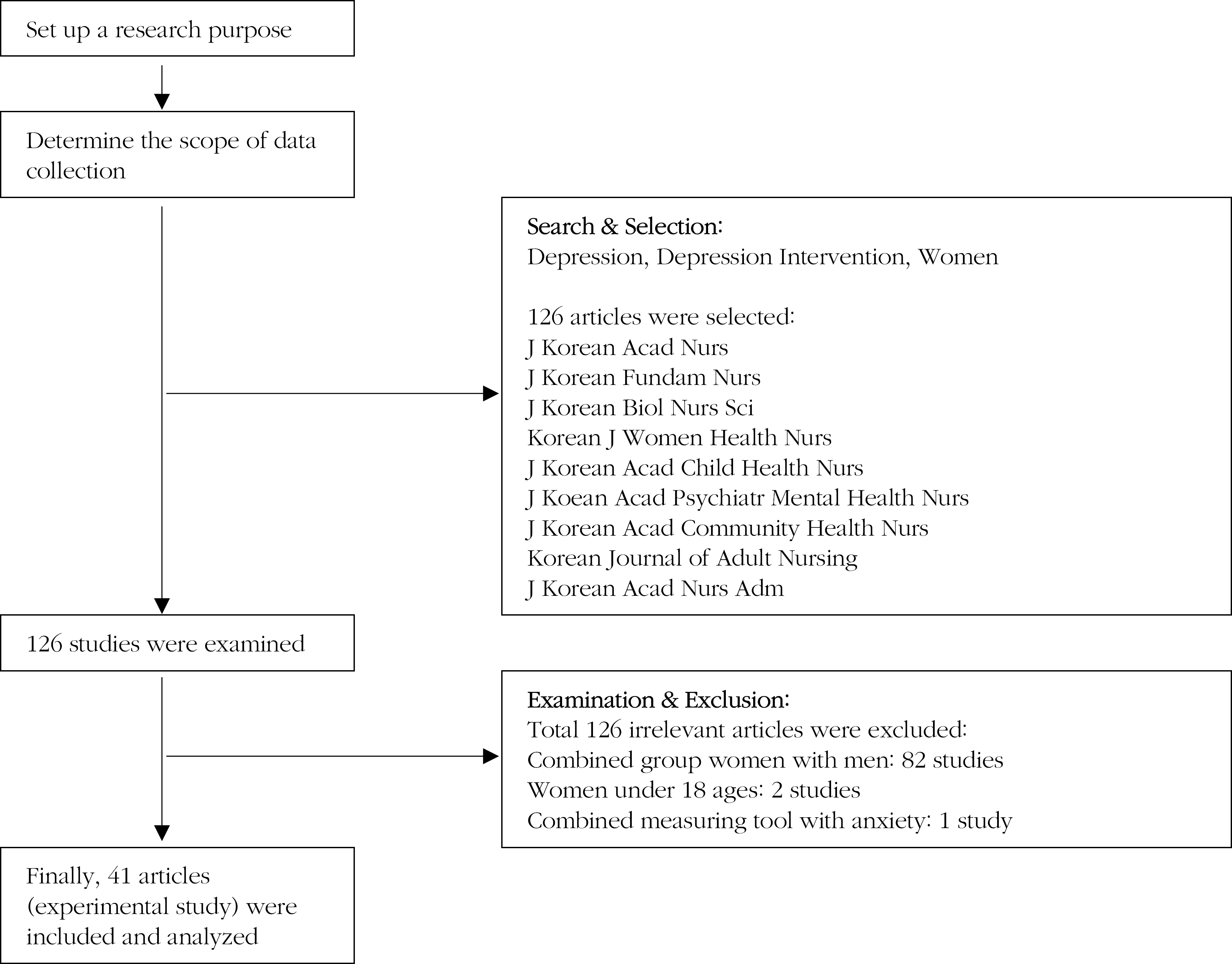Abstract
Purpose
The aim of this study was to provide basic data onthe intervention for depression program development and application by analyzing the depression intervention studies for women that were published in Korea Journal (2000~2014).
Methods
Theresearchmethodused was the integrativereview. Ninestudies were reviewed fromthe NursingArticlesand National AssemblyLibraryof which 41studies werefrom126 researchpapers that met the inclusion criteria and analyzed using MINORS (Methodological Index for Non-Randomized Studies) and according to general characteristics.
Results
There were non-equivalent control group pre-post test design(78%)inresearch design. 44% of articles in sample sizewere 14~26participants andmeasuringtools were used CES-D (29%), BDI (I &II, 22%), GDSSF-K (22%). In qualityof research accordingtoMINORS, most of the papers got 2scores except for the items of sample size calculationstandard. Eventhough the similar intervention program were reported, the results could not compare because of diverse contents, duration, methods, and measuring tool with intervention program. Astheresults, aroma, massage, andcounselingprogramsseemedtohavesignificanteffectsof depression alleviation.
REFERENCES
1. Park CK, Lee JR. Analysis of factors affecting the change of depression of Korean adult male and female. Journal of Health and Social Sciences. 2011; 29:99–128.
2. Beck AT. Depression: clinical, experimental and theoretical aspects. New York: Hoeber Medical Division, Harper & Row;1967.
3. Park JK, Jang SH, Min S. Effects of stretching exercise on quality of life, depression, total cholesterol in the elderly. Journal of Korean Biological Nursing Science. 2002; 4(2):139–150.
4. Kwame MK. Depression. Jeon WT translator. Seoul: Academia;2005.
5. Korea Health Statistics. Korea National and Nutrition Examination Survey (KNHANES V-2) [Internet]. Cheongju: Korea Health Statistics;2011. [cited 2015 May 15]. Available from:. http://Knhanes.cdc.go.kr.
6. Jeon MY, Bark ES, Lee EG, Im JS, Jeong BS, Choe ES. The effects of a Korean traditional dance movement program in elderly women. Journal of Korean Academy Nursing. 2002; 35(7):1268–1276.

7. Kim DO, Lee HS, Kwon YS. The effects of dance sports program on health promotion in rural women. Journal of Korean Biological Nursing Science. 2012; 14(2):84–93.

8. Son JU, Lee JH. The effects of the walking exercise on physiological index, physical fitness, self esteem, depression and life satisfaction in the institutionalized elderly women. Journal of Korean Academy of Community Health Nursing. 2006; 17(1):5–16.
9. Roh KH, Park HA. A metaanalysis of the effects of aromatherapy on psychological variables in nursing. Journal of Korean Academy Community Health Nursing. 2009; 20(2):113–122.
10. Lee SH. Effects of aromatherapy program on depression and fatigue in middle aged women. Korean of Journal of Women Health Nursing. 2002; 8(3):435–445.

11. Kim SM. The effects of aromatherapy and hand massage on anxiety, sleep, and depression in the female aged at residential facilities. Journal of Korean Academy of Community Health Nursing. 2009; 20(4):493–502.
12. Yoo YS, Kang HY. Effects of a bereavement intervention program on depression and life satisfaction in middle aged widows in Korea. Journal of Korean Academy Nursing. 2006; 36(8):1367–1373.

13. Yoo MS, Lee H, Yoon JA. Effects of a cognitive-behavioral nursing intervention on anxiety and depression in women with breast cancer undergoing radiotherapy. Journal of Korean Academy Nursing. 2009; 39(2):157–165.

14. Whittmore R, Knafl K. The integrative review: Updated methodology. Journal of Advanced Nursing. 2005; 52(5):546–553.
15. Slim K, Nini E, Forestier D, Kwiatkowski F, Panis Y, Chipponi J. Methodological index for non-randomized studies (MINORS): Development and Validation of a new instrument. ANZ Journal of Surgery. 2003; 73(9):712–716.

16. Higgins JPT, Green S. Cochrane. Handbook for systematic reviews of intervention: The cochrane collaboration [Internet]. NJ: John Wiley & Sons, Ltd;2008. [cited 2011 December 27]. Available from:. http://www.cochrane-handbook.org.
17. Park SJ, Kim SJ, Kang KA. Integrative review of nursing intervention studies on mother-infant interactions. Child Health Nursing Research. 2014; 20(2):75–86.

18. Zhang JM, Wang P, Yao JX, Zhao L, Davis MP, Walsh D, et al. Music interventions for psychological and physical outcomes in cancer: A systematic review and metaanalysis. Supportive Care in Cancer. 2012; 20(12):3043–3053.

19. Conn VS, Hafdahl AR, Porock DC, McDaniel R, Nielsen PJ. A metaanalysis of exercise interventions among people treated for cancer. Supportive Care in Cancer. 2006; 14(7):699–712.

20. Kim HJ, Kim SY. Quality assessment of non-randomized studies in the Korean Journal of Family Medicine. Korean Journal of Family Medicine. 2009; 30(2):129–137.

21. Jun MH, Uhm DC, Jeong S. The analysis of the Korean nursing research trends on complementary and alternative therapies for cancer patients. Journal of Korean Oncology Nursing. 2009; 9(1):67–75.
22. Song MS, Kim SK, Yoo YK, Kim HJ, Kim NC. Effects of the aquatic exercise program on body fat, skeletal muscle mass, physical fitness and depression in elderly women. Journal of Korean Biological Nursing Science. 2011; 13(3):276–282.
23. Lee SR, Park HS, Cho GY. The effects of tai chi exercise on physical function, stress and depression in middle aged women with osteoarthritis. Journal of Korean Academy of Fundamental Nursing. 2010; 17(2):159–168.
24. Lee SE, Chung KS. Effects of body image improvement program on self-assertiveness and depression in college women. Journal of Korean Academy Psychiatric and Mental Health Nursing. 2002; 11(3):363–374.
Table 1.
Analysis of Research Articles according to General Characteristics (N=41)
Table 2.
Type of Research Design, Tools and their Reliability (N=41)
Table 3.
Assessment of the Risk of Bias according to MINORS (N=41)
X1=Clear purpose statement, X2=Target selection criteria, X3=Prospective data collection, X4=Draw a conclusion that be right to research purpose, X5=Reasonable evaluation about result, X6=Appropriate followup period, X7=Less than 5% of the eliminated, X8=Sample size calculation standard, X9=Appropriate control group, X10=Simultaneous administration of the test and control groups, X11=Homogeneous test between groups, X12=Appropriate statistical analyzes.
Table 4.
Content Analysis of Intervention Studies (N=41)




 PDF
PDF ePub
ePub Citation
Citation Print
Print



 XML Download
XML Download